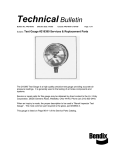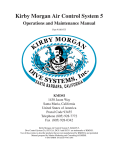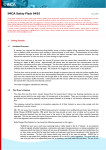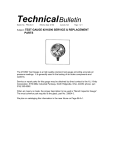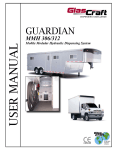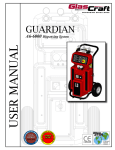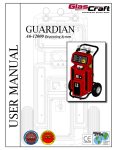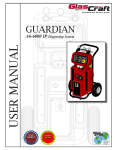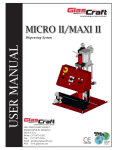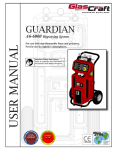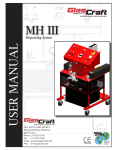Download Kirby 77 User's Manual
Transcript
Kirby Morgan 77 Chapter 3.0 Operating Instructions WARNING This manual is our effort to explain the operation, maintenance and use of the Kirby Morgan helmet. We do not herein make any effort to teach the principles of diving. It is our assumption the reader is a qualified diver. We highly recommend that all divers should train, under controlled conditions, in the use of any model of commercial diving helmet that they have not previously used or trained in, prior to use on the job. 3.1 Introduction This section provides advice on how to use your Kirby Morgan helmet. The use of these diving helmets will vary with the type of work and environmental conditions. The basic procedures of donning and removing these helmets will be similar for every job. The umbilical is the diver’s lifeline to the diving control station. WARNING Kirby Morgan diving helmets are not intended for use with a self contained gas supply (scuba). There is no provision for surface swimming once the scuba air supply is depleted. This could lead to suffocation or drowning, which could be fatal. A proper training program in a calm, clear body of water should be undertaken. If the diver has not used a particular Kirby Morgan helmet before, he must not dive with the helmet without proper training. However, divers that are familiar and trained in the use of previous Kirby Morgan masks; i.e., KMB 8, 9, 10, 18, 28, the Navy MK. 1 Mask, Navy MK. 21 helmet, or the Navy MK. 22 mask or the SuperLite helmets, will find that all Kirby Morgan diving helmets and masks have the breathing system controls located in the same position. The operation of this helmet will also be similar. The diver must be tended at the surface at all times by a trained, qualified commercial diving tender. 3.2 Design Purpose All Kirby Morgan diving helmets are designed for use with an umbilical. The umbilical is usually composed of at least a gas or air supply hose and communication wire, assembled with waterproof tape (and in some umbilicals wound similar to strands in a rope) to form a single unit. Some umbilicals also include a hose for hot water, a pneumofathometer hose, and a strength member, such as a cable or strong line. It is strongly recommended that the air/gas umbilical be married to a strength member in a manner that allows the strength member to receive the strain. This will help reduce the possibility of umbilical and umbilical fitting fatigue and possible failure. The diver must be tended at the surface at all times by a trained, qualified commercial diving tender. © Copyright 1970-2008 Kirby Morgan Dive Systems, Inc. All rights reserved. Document #080626002 41 Kirby Morgan 77 The diver must be tended at the surface at all times by a trained, qualified commercial diving tender. Never dive without a qualified tender holding your diving hose. The diving control station can be at the surface, in a diving bell, or in a submerged habitat. The diving control station is the center of the air/gas supply, communications with the diver, and diving procedures. The station can be as simple as a tender with a set of “phones” (communication amplifier), or as complex as a control van in the midst of a saturation system. WARNING All diving always involves the risk of decompression sickness. Omitted decompression due to loss of gas supply or other accidents can cause serious injury or death. The use of the Kirby Morgan helmets or masks cannot prevent this type of injury. KMDSI manufactures a complete Air Control System, the KMACS 5™ with integrated communications and pneumofathometer. This portable system can be operated on either a high pressure air supply or on a low pressure compressor. The Air Control System has a specially designed high pressure regulator that reduces high pressure air and provides an adequate flow to support divers to a depth of 130 fsw (40 msw) The helmet demand regulator and side block assemblies have been designed to operate with a supply pressure from 130 p.s.i.g. (8.8 bar) to 225 p.s.i.g. (16 bar) over ambient pressure. This wide operating range allows flexibility when using various gas supply systems. WARNING High pressure supply regulators and associated piping systems for surface supplied diving with Kirby Morgan helmets and masks must be capable of delivering a minimum of 3.2 acfm to the diver at depth. Only systems that can deliver the required gas flow should be used. 42 For maximum breathing performance it is desirable to maintain an over bottom supply pressure in accordance with the low-pressure and high-pressure supply tables found in Chapter 2 of this manual. With the many different gas supply console configurations in use, it is important to ensure that the gas supply system used, is capable of supplying the helmet with the necessary pressure and flow of gas to allow the diver to work safely and efficiently. There are also detailed checklists for the set-up and maintenance of your helmet on the Dive Lab web site at www.divelab.com. 3.3 First Use of Your Kirby Morgan Diving Helmet When you first receive your Kirby Morgan diving helmet, carefully unpack it and examine it for any damage that may have occurred during shipment. Use the inspection sheet provided to ensure that no damage has occurred. The purchaser must contact the freight carrier and/or the KMDSI dealer if the helmet has been damaged in shipment. Early production of the REX 77 helmet had a much different surface finish than what is found on current production runs. Earlier helmets shells and components were finished using a combination of glass and Stainless Steel beads; this gave a dull or flat looking surface finish. Later shipments have a surface finish with a much smoother and almost shiny appearance. Although the parts are not shiny, the surface finish is very smooth. A Scotch-Brite®, (or similar non metallic), scouring pad will remove buildup of unwanted surface deposits on both older, and newer REX 77 helmets. It can also be used to give the main helmet components on newer helmets, a satin (brushed ) finish. Be sure to complete the enclosed warranty card and return it to KMDSI immediately. No warranty claims will be honored without a correctly completed warranty card on file at KMDSI. © Copyright 1970-2008 Kirby Morgan Dive Systems, Inc. All rights reserved. Document #080626002 Kirby Morgan 77 3.4 Initial Adjustments to Your Helmet Before using the helmet for the first time, it must be checked and adjusted for proper fit. There are several adjustments that must be made to provide a more comfortable fit when wearing the helmet. 3.4.1 Head Cushion The fit of the helmet is primarily determined by the layers of open cell foam that fill the head cushion bag. The center top/rear foam is very dense to reduce WARNING KMDSI must have your current address to ensure that you receive all safety notices and other important information concerning the helmet. Please notify KMDSI of any change of address. compression and spring-back. This reduces the tendency of the helmet to ride up when underwater. Do not replace this rigid foam with a soft foam. A softer foam is used on the sides and around the bottom of the head cushion. The head cushion should be adjusted for best fit. dam opening so that the two “edges” of the neck dam are parallel. The neck dam must be under slight tension but must not be stretched beyond its normal length. Trim the neck dam with the largest, sharpest scissors available, in order to make as few cuts as possible. There must be no jagged edges on the neck dam or it may tear. Trim only 1/4 inch off the neck dam at a time. When you are done, the neck dam must be just tight enough The diver’s head can be moved forward into the oral nasal mask by adding layers of additional foam at the rear of the head cushion. Do not add to much foam to the rear of the head cushion, as this may position the diver’s chin too far into the oral/nasal mask and create an uncomfortable fit. The diver’s head can be moved up or down in the helmet by decreasing or increasing the foam pads at the top of the head cushion. Usually, a diver with a small head will use all the foam that comes with a new hat. A diver with a larger head will need to remove a layer of foam in the center top and back of the head cushion. The foam may be cut with scissors to provide a better fit, or more foam can be added to give a tighter fit. The chin cushion can also be adjusted if necessary. 3.4.2 Trimming the Neck Dam If your helmet is new, or any time you replace the neck dam, it must be adjusted to fit you. New neck dams are cone shaped and will probably be too tight if not properly trimmed. The neck dam must be trimmed to fit your neck. To trim the neck dam, have your tender hold the neck © Copyright 1970-2008 Kirby Morgan Dive Systems, Inc. All rights reserved. O-ring Neck dam Stepped Ring Split Ring Pull Strap Screw Neck Dam components. WARNING Never dive with a neck dam that is too tight. A neck dam that is too tight could cause the diver to pass out due to pressure on the carotid artery in the neck. This could lead to severe personal injury or death. Document #080626002 43 Kirby Morgan 77 so that it does not leak. This may feel a bit snug out of the water, but should be comfortable underwater. If you have a neoprene neck dam, it may also need to be stretched for it to fit properly. Trim the neck dam until it is still snug, then stretch it by sliding it over a scuba tank and allowing it to sit overnight. If you still cannot get the proper fit by stretching the neck dam, it must be trimmed further. Do not trim more than 1/4 inch at a time. 3.4.3 Adjusting the Neck Pad Another component that controls the fit of the Kirby Morgan helmet is the adjustable neck pad. The neck pad, which is mounted on the locking collar, slides back and forth along the locking collar body for adjustment to fit different divers. Two screws and adjustment nuts lock the neck pad plate to the locking collar. Loosening these screws from the mount nuts allows the neck pad to be adjusted. CAUTION Trimming the neck dam. As the neoprene neck dam ages, it will become looser, due to a natural breakdown of the cells. This is particularly true if the helmet is locked in and out of a bell or saturation system. As the neck dam becomes worn it will need replacement to ensure that it seals properly. Washer Teflon Washer Washer Avoid trimming neoprene neck dams too much. Neoprene neck dams will loosen over time as they are used and the cells of the foam neoprene break down. If you trim the neck dam too much it will be too loose and will leak. Trim the neck dam until it is snug, then stretch it before use. The following procedure requires a diver and tender. You do not need to have the air on to the helmet if you do not use the neck dam ring assembly. If the neck dam assembly is used, the diver must have air to the helmet to breathe. With the helmet face down on a suitable surface, pull and turn each of the sealed pull pins until they are locked open. Swing the locking collar/neck pad as- Nut Adjustment nut Locking collar Hinge bolt Washer Screw Locking Collar components. T-washer Neck pad 44 © Copyright 1970-2008 Kirby Morgan Dive Systems, Inc. All rights reserved. Document #080626002 Kirby Morgan 77 sembly out away from the base of the helmet. Slightly loosen the screws until the neck pad can slide back and forth. Be sure each of the head cushion snaps are attached to their corresponding fitting inside the helmet. Pick up the helmet and pull the nose block device knob out fully. Position the helmet on your head so the oral nasal is in the proper position on your face, covering your nose and mouth. Turn the sealed pull pins to the locking position with the ridge on the pins engaging the notch in the sleeve and the pins fully retracted. 3.5.1 Pre-Dive Visual Inspection Visually inspect the exterior and interior of the helmet. 1) Inspect the regulator cover for any damage. The purge button must work. 2) The neck dam must not be torn or punctured, and properly trimmed to fit. WARNING There must be no holes in the neck dam. If there are any holes in the neck dam the helmet could leak or flood. In addition, the demand regulator will not operate properly. Drowning could result. Tilt your head forward so the locking collar/neck pad assembly may be swung forward and locked up into its closed position. The sealed pull pins must snap into place on the locking collar. Lift your head back up and slide the neck pad forward until it is snug but comfortable. Mark the position of the neck pad on the locking collar using an indelible marker. Pull the sealed pull pins out to their unlocked position and let the locking collar open. 3) Inspect the O-ring on the neck dam ring assembly. The O-ring must be in place, undamaged, and lubricated. Remove the helmet. Position the neck pad plate on the locking collar at the marked position and tighten the screws on each side. After the adjustment screws are tightened, don the helmet again, tilt your head forward and lock the locking collar/neck pad assembly. Move your head in various positions to make sure the pad is adjusted for comfort. The O-ring on the neck dam ring assembly on the Kirby Morgan helmet must be in place and in good condition. It must be properly lubricated for smooth operation. Without a proper functioning O-ring the helmet will leak and possibly flood. Drowning could result. The helmet is now adjusted for your head. It should need no further adjustment unless another diver uses the helmet. 4) Inspect the bent tube that supplies breathing gas to the regulator. There must be no dents or kinks in the assembly. 3.5 Pre Dress-In Procedure 5) Inspect the face port. It must be in good condition. Before dressing in for a dive, inspection of the helmet systems must be made to be sure it is in proper working order. This must be done well in advance of the dive so any problems can be fixed without delaying the dive. The following steps are part of the recommended daily maintenance. WARNING 6) Be sure the communications wires are hooked up and tested. 7) Inspect the oral/nasal mask. Make sure it is on the regulator mount nut properly and the valve is installed properly. 8) Inspect the sealed pull pin on each side of the helmet. They must engage and disengage properly. 9) Make sure the head cushion and chin cushion are properly fastened inside the helmet. The chin strap should be open as wide as possible. © Copyright 1970-2008 Kirby Morgan Dive Systems, Inc. All rights reserved. Document #080626002 45 Kirby Morgan 77 10) Check the screws on the port retainer . They must be adjusted to the proper torque setting specifications noted in Appendix 1 of this manual. Binder head screws are used in this application for their self locking characteristics. WARNING All parts on Kirby Morgan diving helmets must be adjusted to their proper torque specifications. See Appendix 1 for a complete listing of torque specifications for each part. Failure to adjust parts to the recommended specifications could lead to helmet failure and accidents. This could be fatal. 3.6 Preparing the Helmet for Diving 3.6.1 Clean Face Port Thoroughly clean the face port with a soft cloth and a mild liquid soap solution. DO NOT USE ANY AEROSOL SPRAYS ON THE POLYCARBONATE PORT! 3.6.2 Check Moving Parts Check all moving parts, such as the regulator adjustment knob, the defogger control knob, emergency (EGS) knob, and the nose block device knob and all locking collar parts to ensure smooth and proper operation. 3.6.3 Check Communications Check the communications system for proper operation. Put the helmet on and talk to an assistant on the amplifier. If you are by yourself, with the helmet off take the helmet near the amplifier and tap on each earphone and the microphone, listening to the taps on the amplifier/speaker. Talk into the amplifier/ speaker feeling the vibration on each earphone and the microphone with your fingertips. Check the fit and tightness of the comm module mount nut. 3.6.4 One Way Valve Check The one way valve must be tested daily, prior to commencement of diving operations. 1) Prior to attaching (or pressuring up) the umbilical, close the emergency valve knob, attach and pressure up the emergency hose. Shut off the defogger control knob and screw in the adjustment knob on the regulator all the way. 2) With the emergency hose pressurized, turn on the emergency valve knob. If any gas escapes out the end of the adapter, the one way valve is faulty and must be rebuilt or replaced. A one way valve repair kit is available to rebuild these valves (Part # 525-330). You can test the one way valve by connecting the bailout bottle to the emergency valve and pressurizing the sideblock. There must be no gas leakage through the one way valve. 46 © Copyright 1970-2008 Kirby Morgan Dive Systems, Inc. All rights reserved. Document #080626002 Kirby Morgan 77 WARNING The one way valve must be tested daily, prior to commencement of diving operations. Failure of the one way valve could cause serious injury or death. 3.7 Emergency Gas System (EGS) If the diver’s main gas supply fails, the diver must have another source of gas that will enable him to return to the dive station or to a point where a normal gas supply can be reestablished. For this reason, an emergency gas supply (bailout) cylinder must be used on all dives. The bailout cylinder is normally worn on the back using a combination backpack and lifting harness. WARNING Do not dive without a diver worn Emergency Gas System. If the main gas supply is lost, you will have nothing to breathe and may drown. You can also test the one way valve by attempting to suck air through the valve. The emergency valve must be open for this test to work properly. If you are able to suck any air through the valve it is not working properly. WARNING Never dive if the one way valve is not operating properly. If the hose or breathing gas/air fitting breaks near the surface a serious injury could result to the diver’s lungs and/or eyes. In extreme cases this could be fatal. The one way valve must be tested daily prior to the commencement of diving operations. Diver donning a complete bail-out system. Most commercial divers wear a harness (separate from the weight belt) that is used for several purposes. The harness is fitted with large metal rings (usually brass or stainless steel). The umbilical is hooked into one of these rings to keep any strain off the helmet. In addition, the rings on the harness are used to hang tools and other equipment. Usually the harness is also designed to provide a means of lifting an unconscious diver from the water. This harness is the best method of securing the emergency breathing gas to the diver. © Copyright 1970-2008 Kirby Morgan Dive Systems, Inc. All rights reserved. Document #080626002 47 Kirby Morgan 77 WARNING Never dive without attaching the umbilical to some type of harness or clip on the diver’s body. Never allow the umbilical to pull on the helmet directly or the diver could suffer a neck injury. A small tank can be mounted horizontally on the lower rear or front, while larger tanks are usually mounted vertically in the center back similar to a Scuba diver’s tank. Some harness designs incorporate a cloth enclosure into which the tank fits. The entire tank, valve, and regulator are enclosed in fabric. This helps to prevent snagging. European C.E. ONLY In European countries that have adopted C.E. certification, only C.E. certified cylinders are allowed to be used and must have a minimum charged capacity available to the diver of 1400 N/l (50 scf). The emergency gas supply must only be fitted with a KMDSI first stage regulator and have a KMDSI over pressure relief valve installed (Part # 200-017). The relief must be adjusted to start lifting at approximately 180-200 p.s.i.g. (12.4-13.8 bar) above the regulator intermediate setting. The purpose of the relief valve is to allow pressure to vent off in the event the first stage regulator develops a leak or creeps. Without a pressure relief valve, the hose could rupture and the emergency gas supply would be lost. WARNING A standard Scuba submersible pressure gauge must be connected to the high pressure port on the first stage so that the diver can monitor his emergency supply. Use a good quality first stage for your emergency gas supply. The diving harness must have a provision for attaching the emergency gas supply and a place to attach the diver’s umbilical. When determining the size of the emergency gas cylinder to use, several factors must be considered. The divers depth, the length of time the diver may be without the main gas supply, and the gas consumption rate. Regardless of the cylinder used, it should be of sufficient volume to allow the diver to ascend at a normal rate or transit to a point where a normal gas supply can be reestablished. 48 The emergency air/gas tank must be fitted with a good quality first stage regulator to reduce the pressure to less than 225 p.s.i.g. (16 bar) ambient diver pressure. Connect the first stage hose with a set of quick disconnecting locking sleeves to the emergency valve assembly located on the side block. The first stage regulator must have at least two low pressure ports. One port is used for the connector hose to the emergency valve and the second is used to install an overpressure relief valve (Part #200-017). If the first stage develops a leak, the full pressure of the tank could be placed on the low pressure hose. This could cause the hose to burst. The overpressure relief valve will bleed off any leak. © Copyright 1970-2008 Kirby Morgan Dive Systems, Inc. All rights reserved. Document #080626002 Kirby Morgan 77 Make sure the emergency valve knob is turned off, otherwise the emergency gas supply will be used up without the diver’s knowledge. Once the emergency supply hose is connected, the tank valve is turned on to pressurize the hose. In the event of an emergency due to a loss of the main gas supply, the emergency valve knob located on the side block is turned on supplying gas to the side block assembly and the regulator. An over-pressure relief valve must be installed on the first stage used for the Emergency Gas Supply. WARNING Never dive without an over pressure relief valve installed on the EGS regulator (1st stage). Without the relief valve if the EGS regulator develops an internal leak, or carries-away, the full pressure of the EGS cylinder would be placed on the low-pressure EGS hose and the Emergency Valve. This could cause the low-pressure hose to burst resulting in the complete loss of the EGS system. There are risks with each method of configuring your bail-out system. There is a risk that if you have the bail-out bottle on and the emergency valve on the helmet closed, that the emergency gas could be lost if the hose or the first stage itself develops a leak. However, KMDSI believes that this method poses the least amount of risk for the diver. Probably the most serious problem with any of the other possible configurations is that the first stage will almost certainly flood if it is not pressurized while you are underwater. If the regulator floods and is not promptly serviced, it will not perform properly when you need it in an emergency. As a diver, you always must decide how much risk and what types of risk you are willing to expose yourself to when you dive. It’s up to each individual to make an informed choice regarding how to configure your bail-out system. We cannot make this choice for you. WARNING Never connect the main gas supply hose from the diving control station to the Emergency Gas valve assembly (EGS). If this is done there is no one way valve protection for the diver in the event of damage to the umbilical or related equipment. The diver could be exposed to a serious “squeeze”. This can result in serious personal injury or death. Always be sure to check the pressure in your bail-out bottle before you dive. KMDSI strongly recommends the use of a submersible pressure gauge with every bail-out system. Not only does this make it very easy to check your emergency gas pressure prior to diving, it also allows you, in most cases, to periodically check the pressure in your system while you dive. In this way, if you have a leak, you will probably figure it out and will be able to take appropriate action. © Copyright 1970-2008 Kirby Morgan Dive Systems, Inc. All rights reserved. Document #080626002 49 Kirby Morgan 77 There are several possible ways to configure your emergency gas system, although at KMDSI we only recommend one method. The configuration we recommend is as follows: Cylinder Valve Open - EGS Valve on Helmet Closed This is the only method that we recommend. The advantages of this method are as follows: • You only need to open one valve to activate your emergency supply. • There is little danger of flooding your first stage regulator and ruining it. Possible Emergency Gas Supply Cylinder & EGS Valve Configurations Configuration Cylinder Valve EGS Valve Advantages/Disadvantages Configuration 1 (Regulator pressurized) On Off Advantages • One valve to open • First stage won’t flood Disadvantages • If hose or first stage leaks some or all EGS gas will be lost Configuration 2* (No pressure in regulator) Off On Advantages • One valve to open • No loss of gas from cylinder if hose leaks or regulator leaks Disadvantages • First stage will flood and must be serviced after each day of diving Configuration 3* (Regulator pressurized then cylinder valve closed) On momentarily then Off Off Advantages • No loss of cylinder gas if hose or regulator leaks Disadvantages • Two valves to open in emergency • Slow leak on long dive may result in flooded 1st stage • If dive depth exceeds pressure in first stage, first stage will flood Configuration 4* Off Off Advantages • No use of cylinder gas unless emergency occurs Disadvantages • Regulator will flood and need service daily • Two valves to open in emergency * Requires ability to reach cylinder valve without difficulty 50 © Copyright 1970-2008 Kirby Morgan Dive Systems, Inc. All rights reserved. Document #080626002 Kirby Morgan 77 WARNING Some divers, keep the EGS gas cylinder valve shut during the dive. Their rationale being; in the event of an emergency, they will simply open the EGS cylinder valve thus eliminating any EGS air/gas unknowingly being lost due to either a 1st stage failure or EGS hose failure. KMDSI strongly recommends never diving with the EGS cylinder valve shut. The reasoning behind this is twofold. First, with the EGS cylinder valve open, gas is immediately available in the event of topside gas interruption via the EGS valve on the side block simply by opening it. Secondly, and most importantly, if the EGS regulator (1st stage) is not pressurized, during descent it is possible that sea water will leak through the first stage intermediate circuit and regulator, causing failure of the EGS regulator if not frequently serviced and resulting in possible injury or death. You can use a quick-disconnect whip to connect the EGS valve to the bail-out bottle. This makes dressing the diver much easier. © Copyright 1970-2008 Kirby Morgan Dive Systems, Inc. All rights reserved. Document #080626002 51 Kirby Morgan 77 3.8 Setting Up to Dive 3.8.1 Flushing Out the Umbilical Before connecting the umbilical to the helmet, the umbilical must be flushed out to remove any dirt, moisture, or other debris. Connect the topside umbilical end to the topside diver control console. Ensure there is no pressure in the divers umbilical. Carefully uncap the helmet end of the umbilical and hold securely while pointing in a safe direction, then slowly bring up gas pressure to approximately 25-40 p.s.i.g. (1.7-2.7 bar). Allow the gas to flow for at least 15 seconds. If it is not going to be used immediately, the umbilical should be recapped. WARNING If the one way valve or the adapter is loosened this will allow breathing gas to leak out of the breathing system. This could also result in a loss of all pressure to the helmet, leaving the diver with nothing to breathe. 3.8.2 Connecting the Umbilical to the Helmet When you connect the hose to the helmet be sure to use a wrench to hold the adapter, or inlet fitting, and a second wrench to turn the swivel fitting on the hose. If this is not done, the adapter will turn inside the one way valve. If this happens repeatedly the threads will wear and the valve will need to be replaced. Connecting the umbilical to the helmet. The connection between the hose and the helmet must only be made up “snug”. Excessive force will deform and ruin the adapter. A second wrench must be used when the helmet is disconnected as well, otherwise the adapter and/or the one way valve assembly may become loose and fail to make a seal. If you are using waterproof connectors for your communications, take extra care in handling these pieces. To connect the male and female parts, align the large pin on the male connector with the yellow mark on the female connector. Press the two connectors together until you hear a distinct “pop”. Do not twist the connectors. Tape the two connectors with a bit of electrical tape to prevent them from pulling apart. To separate the connectors remove the tape, grasp them at the thickest part, place your thumbs against each other, and push apart until the connectors are disconnected. Connecting the waterproof connectors. Do not twist the connectors. Do not pull them apart by pulling on the thin part of the wires. 52 © Copyright 1970-2008 Kirby Morgan Dive Systems, Inc. All rights reserved. Document #080626002 Kirby Morgan 77 3.8.3 Opening the Breathing Gas Supply to the Helmet Prior to turning on the air supply for the helmet, check to see that the free flow valve is closed and the regulator adjustment knob is all the way in. Slowly bring up the gas pressure to the helmet to 150 p.s.i.g. (10.2 bar). Slowly back out on the regulator adjustment knob until a slight free flow develops, then turn the adjustment knob in (clockwise) until the free flow just stops. To properly check the breathing system you must completely don the helmet. 3.8.4 Fogging Prevention A thin film of anti-fogging solution may be applied to the interior of the polycarbonate face port prior to the dive to help prevent fogging during the dive. A mild liquid dish washing detergent, or other commercially available anti-fogging solutions, may be applied with a soft rag or paper towel to the interior of the port. The diver should use a solution which has been found satisfactory in the past. However, do not use an aerosol spray on the polycarbonate lens. The propellants in some aerosol dispensers cause damage to the lens. WARNING A thin film of dish soap or other anti-fogging solution should be applied to the lens prior to the diver donning the helmet. Never use any aerosol propelled sprays near the face port of the any Kirby Morgan helmet or band mask. The propellant used in these aerosols can invisibly damage the polycarbonate face port and cause it to shatter upon impact from any strong blow. If the face port fails underwater the helmet will flood and drowning may result. © Copyright 1970-2008 Kirby Morgan Dive Systems, Inc. All rights reserved. Document #080626002 53 Kirby Morgan 77 3.8.5 Donning The Kirby Morgan Helmet All donning procedures must be done by the diver until he is thoroughly at home with the helmet. This will train for familiarity. However, the tender must be present to assist the diver and check to ensure that the diver has properly donned his equipment. It is impossible for the diver to see whether he is properly dressed in once the helmet is on his head. To dress in, the neck dam ring assembly must first be pulled down over the diver’s head. Be sure to loosen the chin strap inside the helmet prior to donning the neck dam. To loosen the strap, place your thumb on top of the rounded end of the plastic buckle and pull down, away from the helmet. To don the neck dam, hold the neck dam/ring assembly vertically, in front of your chest, so that the large end of the assembly where the pull strap is mounted is on top. The pull strap should both be facing your chest. Lift the neck ring assembly over your head, grasping the front and rear of the neck ring assembly. Pull the neck dam down over your head. The neck dam should be as low as possible on your neck. The neck dam is always turned up against the diver’s neck. This is very important! WARNING The tender must always be present to assist the diver while dressing and whenever the diver has his helmet on his head while he is out of the water. It is difficult for the diver to walk while he is dressed in and he can stumble and fall, resulting in serious personal injury. With the neck dam turned down, the helmet will vent air from the neck dam causing the regulator to free flow. This will make the helmet very uncomfortable. The neck dam ring assembly must be oriented so the “tongue” on the front of the neck dam ring assembly is pointed to the front of your body, in front of and below your chin. You should be able to look down and see the tongue sticking out from underneath the neck dam ring assembly when you are wearing the assembly and it is oriented properly. With the diver holding the helmet, the tender should now connect the quick disconnect fittings for the bailout supply. Open the regulator adjustment knob and the defogger control knob for a steady flow from both just prior to the diver dressing into the helmet. The tender must be available to assist the diver while he is dressing into his helmet. 54 © Copyright 1970-2008 Kirby Morgan Dive Systems, Inc. All rights reserved. Document #080626002 Kirby Morgan 77 Open the locking collar/neck pad assembly fully. The diver inserts the tongue on the neck dam/ring assembly into the swing tongue catch. The tender must check to see that this is properly engaged. The locking collar must be completely open for the diver to don the helmet. Push the neck dam/ring up into the neck ring on the base of the helmet . With the helmet face down, pull the sealed pull pins and open the locking collar/neck pad assembly fully. Be sure the head cushion is attached to the bottom of the helmet. Pull the nose block device knob out all the way. With the locking collar/neck pad assembly fully open, lift the helmet and place it over your head. Lower the helmet onto the back of your head first, then pivot it forward until your face is in position against the oral nasal mask. Loosen the chin strap all the way. The helmet is worn most comfortably when the chin cushion against the diver’s chin with the chin strap outside of the chin cushion. The locking collar/neck pad assembly must be open and hanging down behind your shoulders. Tighten the chin strap so that it is comfortable under your jaw. Now, the neck dam/ring assembly is resting directly © Copyright 1970-2008 Kirby Morgan Dive Systems, Inc. All rights reserved. Document #080626002 55 Kirby Morgan 77 Although the diver must be capable of donning and removing the helmet himself, the tender must ensure that the helmet is properly secured on the diver. under the hat on the diver’s shoulders. The diver inserts the tongue on the neck dam/ring assembly into the swing tongue catch on the bottom front of the helmet. Grasp the base of the helmet with your fingers and push the neck dam/ring up into the neck ring on the base of the helmet. The neck dam ring fits very snugly in the neck ring. The diver then tilts his head and the helmet forward and swings the locking collar up over his shoulders. Push the locking collar/neck pad assembly up into position until it locks with the sealed pull pins. Rotate the sealed pull pins into the locking position. If you have not positioned the sealed pull pins into the locking position, do it now with the locking collar/neck pad assembly in place. WARNING Both sealed pull pins must properly click into position on the base of the helmet. If the pins are not engaged correctly the neck dam/ring assembly may not seal and the helmet could flood. The diver could drown as a result. 56 © Copyright 1970-2008 Kirby Morgan Dive Systems, Inc. All rights reserved. Document #080626002 Kirby Morgan 77 3.8.6 Testing the Breathing System Test the defogger system by turning on and off the defogger control knob. There should be no leakage when the valve is closed. The regulator should be adjusted by turning the adjustment knob out until a slight steady flow starts, then back in until the flow just stops. is installed and the locking collar closed. When the diver attempts to inhale, a suction on the neck dam is formed, indicating he is achieving a good seal. The diver must then turn the air on immediately so that he can breathe. If the diver does not turn the air on he will not be able to breathe, unless the neck dam is pulled away from his neck. WARNING Next, the demand regulator system is checked for proper function: breathe in and out. Inhalation and exhalation effort should be nearly unnoticeable. Press in on the regulator cover. This should produce a strong burst of breathing gas. Do not perform this test unless the diver and his tender are stationed immediately adjacent to the diver’s air manifold and you are certain the air is on to the manifold. If the diver is unable to flow air to the helmet, either through the umbilical or the bailout, he may not be able to remove the helmet easily. To break the seal in this situation, the diver must put his hand between the neck dam and the neck, and pull the neck dam away from the neck. A tender must be standing by to assist the diver in removing the helmet if needed. Suffocation could result. Test the breathing system to make sure that it is operating correctly. 3.8.7 Sealing Integrity Check If there is any doubt that the helmet is sealing properly, perform the following test prior to diving. Turn the supply gas off at the dive control system and bleed the umbilical. 3.8.8 Adjust Regulator for Low Work Rates At very low work rates, such as when the diver is resting, or during in-water decompression, the diver’s respiratory rate may be quite slow (10-15 breaths per minute). When this occurs, the diver’s exhalations may not be sufficient to move enough breathing gas through the mask exhaust to adequately wash out carbon dioxide (CO2), if the oral/nasal does not have a good fit on the diver’s face. In order to ensure that carbon dioxide does not accumulate in the mask, divers who are at rest underwater should screw the regulator adjustment knob “out,” i.e., away from the regulator, until a slight steady flow occurs and the regulator can be heard to hiss. This will help to eliminate any excess carbon dioxide from the mask. You can also open the steady flow valve (defogger) until a slight hiss is heard. To perform this test, the diver must have an assistant standing by. The assistant should be in control of the gas supply console in the event the diver needs air or he must be ready to lend a hand. The diver must be next to the dive control manifold so that the air may be turned on instantly, or the diver must be ready to run a hand between his neck and the sealing neck dam in order to pull the neck dam away from the neck to allow breathing. With the neck dam ring on the diver’s head, the helmet © Copyright 1970-2008 Kirby Morgan Dive Systems, Inc. All rights reserved. WARNING Excess carbon dioxide (CO2) is dangerous. Too much carbon dioxide in the diver’s breathing system can cause the diver to feel that he cannot breathe for comfort. It can also cause headache, confusion and rapid breathing. In extreme circumstances, carbon dioxide can cause unconsciousness. This could lead to suffocation and death. Document #080626002 57 Kirby Morgan 77 3.9 Removing the Helmet To remove the Kirby Morgan helmet, start by pulling out (forward) on each sealed pull pin and turning so each remains in the open position. Tilt your head, and the helmet, forward and swing the locking collar assembly back behind your shoulders. Tilt your head upright again and push the swinging tongue catch forward with one hand and hold it in this position. Grasp the pull strap and pull down on it, towards your back. This will break the seal between the neck dam/neck ring and the helmet neck ring on the base of the helmet. Once the seal is broken the neck ring assembly will come loose from the helmet. With the locking collar open, you can use the pull strap to break the seal between the neck dam ring and the helmet ring. Pull the nose block device knob away from your face, loosen the chin strap, and lift the helmet off of your head. A good tender will be prepared to help the diver with the removal of the helmet as required. Grab the neck ring at the front and use your fingers to gather the neck dam away from your neck in the front. Lift the neck dam over your head. 58 © Copyright 1970-2008 Kirby Morgan Dive Systems, Inc. All rights reserved. Document #080626002 Kirby Morgan 77 3.10 Diving Procedures 3.10.1 Standing By to Dive The diver may wear the neck dam ring assembly without discomfort if he is standing by to make a dive. However, the helmet itself must always be the last thing put on before the diver enters the water. Everything else must be ready to go before the diver puts the helmet on so he won’t have to support the weight of the helmet while out of the water. 3.10.2 Attaching the Umbilical to the Harness The umbilical must now be hooked to the diver’s harness by means of a suitable clip that is bound to the umbilical. Some divers and companies prefer a quick release clip and others prefer a clip that is screwed together so the diver cannot easily remove it from his harness. The securing of the umbilical keeps the pull of the hose at the diver’s harness and not on the helmet. WARNING Never dive without attaching the umbilical to some type of harness or clip on the diver’s body. Never allow the umbilical to pull on the helmet directly or the diver could suffer a neck injury. 3.10.3 Diver Dons Helmet The diver dons the helmet as per Section 3.8.5. 3.10.4 Diver Check Gas Flow Systems The diver must check out the breathing system himself as the tender finishes dressing him. Operate the defogger valve, the demand regulator, and the purge button to assure yourself of proper operation before entering the water. 3.10.5 Communications Check The communications system, sending and receiving, should be checked at this point. 3.10.6 Diver Ready The diver is now ready to enter the water. He should be assisted to the water if needed. If a welding lens is being used, make sure it is hinged up all the way if the diver is making a jump entry. We do not recommend jump entries. A quick overall inspection by the tender is done and the diver is given the OK. 3.10.7 Water Entry and Descent The tender must make sure there is a sufficient length of umbilical clear if the diver is using a jump entry. There must be no chance of the umbilical hanging up when the diver jumps. Also, the defogger valve should be turned on maintain sufficient pressure in the helmet to prevent the possibility of water pressure It is essential for the diver to ensure that the breathing system is working properly before he enters the water. Note the correct attachment of the diver’s umbilical to his harness and the use of a submersible pressure gauge for the bailout system. © Copyright 1970-2008 Kirby Morgan Dive Systems, Inc. All rights reserved. Document #080626002 59 Kirby Morgan 77 from inverting the helmet exhaust valve when hitting the water. The diver must report to the surface immediately after the entry. It is a good policy to descend 10 or 20 FSW (3-6 MSW), pause and check the regulator adjustment knob to ensure adjustment for the least breathing resistance. The purpose of this adjustment knob is to allow the diver the ability to compensate for variations in umbilical supply pressure. This adjustment device operates by simply increasing or decreasing the amount of spring bias tension on the demand regulator inlet valve. This adjustment device is not intended as a minimummaximum device. Minimum and maximum applies to supply pressure only. The adjustment knob should be adjusted by the diver to be at the easiest breathing setting at all times. Diving a KMDSI helmet or band mask with a bias setting greater than that just necessary to keep the demand valve from free flowing increases the work of breathing and reduces the diver’s ability to perform heavy work. Then the diver checks in with the surface before descending to the job. If a closed bell is being used, the diver enters the water from the bell and pauses for a short time outside the trunk until he is sure all systems are operating properly. During the decent the communications must be checked again and the diver supply pressure should be adjusted as necessary to maintain the required over-bottom pressure. It may be necessary for the diver to readjust the demand regulator by means of the adjustment knob once at the work site to compensate for the variation in umbilical supply pressure. 3.11 Emergency Procedures 3.11.1 Flooding In the event of partial or complete flooding, the diver may clear the helmet quickly by tilting the helmet forward and slightly down and activating the defogger control knob. Pressing in on the manual purge button in the center of the regulator cover will dewater the regulator. After clearing, cautiously check for additional flooding. If the helmet continues to take on water, return to the diving station, swimming with the water dump valve positioned at the lowest part of the hat: that is with the diver’s face forward and slightly tilted down. Keep the free flow knob on. This increases the air/gas pressure slightly inside the hat and keeps the water out. Any incoming water is automatically purged. 3.11.2 Inhalation Resistance If breathing becomes difficult, adjust the demand regulator adjustment knob, for easier breathing by rotating the adjustment knob counter clockwise. If the breathing does not get noticeably better, press the purge button in the regulator cover. If a surge of gas does not flow with this action, open the emergency valve. If the flow is noticeably better, immediately notify topside that you are on emergency gas. Insure your umbilical is clear and return to the stage or decent line. The diver should stay in communication with topside personnel and make preparations to abort the dive. The console operator should check to ensure the supply pressure to the diver is at the proper pressure. 3.11.3 Gas Flow Stops A stop of flow in the demand regulator usually indicates the main gas supply has stopped. The diver should first open the emergency valve by turning the knob. If there is still no flow from the demand regulator, the defogger valve knob should be opened. Keep in mind that if the defogger valve is left open, the bailout bottle will drain very quickly, particularly if the diver is deep. Immediately notify topside, check to insure your umbilical is clear and return to the diving station using the emergency breathing supply. Avoid making a rapid ascent if at all possible. Once at the surface, or inside the bell, the diver may remove the helmet if needed. Never ditch the helmet underwater unless conditions absolutely require that. 60 © Copyright 1970-2008 Kirby Morgan Dive Systems, Inc. All rights reserved. Document #080626002 Kirby Morgan 77 3.11.4 Demand Regulator Free Flow If the demand regulator free flows, turn the adjustment knob in (clockwise) until it stops. If the free flow cannot be stopped, the dive should be aborted. Even if there is no serious problem to the diver, the dive should be aborted and the problem with the regulator corrected. Sometimes it may be necessary to tilt your head so the regulator is face up to help stop the regulator in a free-flow situation. DANGER Rapid ascent is dangerous. It can lead to air embolism or decompression sickness. Air/gas embolism can cause immediate loss of consciousness and/or death. Even on a no decompression dive, a rapid ascent may cause decompression sickness. A diver must only make a rapid ascent when he is in immediate danger of death by drowning or asphyxiation. DANGER Ditching the helmet underwater must be avoided. If the diver ditches the helmet underwater he will not be able to see. In many instances, even if the air supply is interrupted, topside will be able to get it back on line quickly. Do not ditch the helmet underwater unless you are completely out of breathing gas and it is impossible to return to the surface due to entanglement of your equipment or similar circumstances. WARNING Never remove the diving helmet while you are in the stage. If you fall out of the stage with the helmet off but still attached to your harness it may be very difficult to swim. Drowning may result. © Copyright 1970-2008 Kirby Morgan Dive Systems, Inc. All rights reserved. Document #080626002 61 Kirby Morgan 77 3.12 Post Dive Procedures 3.12.1 Removing the Equipment After the diver is well clear of the water he may remove the helmet. If the diver is working out of a stage he must not remove the helmet until the stage is on deck. by removing it from the helmet, squeezing excess water out, and letting the head cushion hang dry or putting it in a clothes drier on air dry only. 3.12.2 Removing the Helmet Remove the helmet by pulling the sealed pull pins out (forward) and turning them until they are locked open in the extended position. Tilt your head and the helmet forward and swing the locking collar back behind your shoulders. You will need to pull down on the pull strap to break the seal between the neck dam ring and the helmet ring and to disengage the neck ring from the swing tongue catch. Once the neck ring is disengaged from helmet ring, you can loosen the chin strap and then lift the helmet off of your head. A good tender will be prepared to help the diver with the removal of the helmet as required. The emergency gas supply hose may be disconnected while the diver leaves the helmet on or while he holds the hat after removal. The quick disconnect makes this procedure very easy. The tender should then unfasten the umbilical from the harness and take the helmet from the diver and set it aside. (Closing the locking collar/neck pad assembly onto the helmet before setting the hat down on a rough deck will help protect the helmet neck ring from damage). The harness and bailout bottle is then removed. The helmet should be rinsed with clean fresh water following each use, then thoroughly cleaned. WARNING Use only the air dry setting when drying head cushion foam in a drier. Use of a higher setting could cause the foam to melt or start a fire. 3.12.3 Storage of the Helmet Between Dives The helmet should be maintained per the daily maintenance section in Chapter 6. If the helmet is not going to be used for a period of time, the head cushion, should be removed. The head cushion should be dried and replaced in the hat before storage. The regulator adjustment knob should be unscrewed all the way out (counterclockwise) until the next dive. Be sure to check the communications components and allow them to fully dry. When the helmet is completely dry, or the diver is ready to leave the job, the helmet should be stored in the carrying bag to protect it. If the head cushion becomes wet it may be dried out 62 © Copyright 1970-2008 Kirby Morgan Dive Systems, Inc. All rights reserved. Document #080626002























